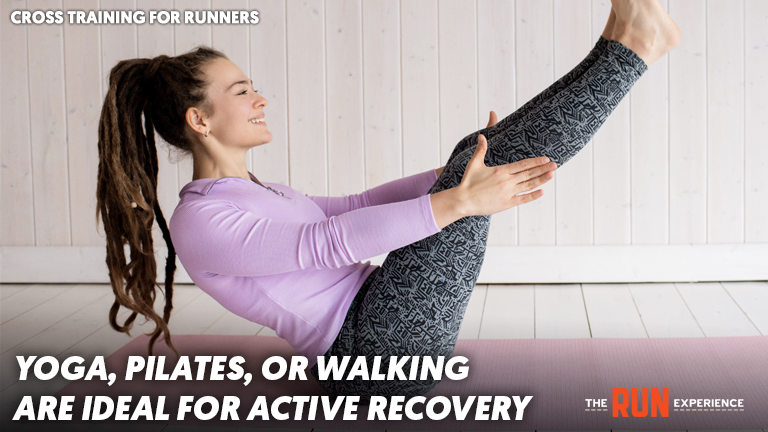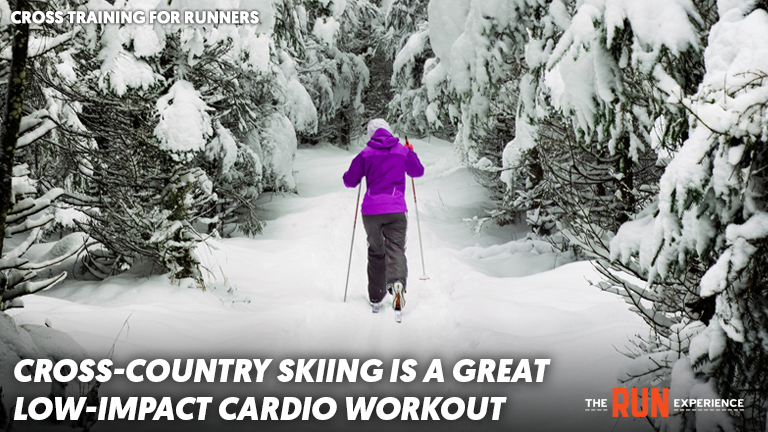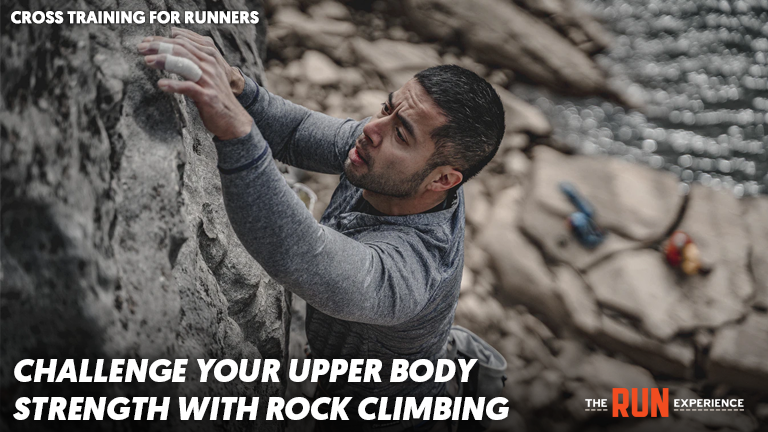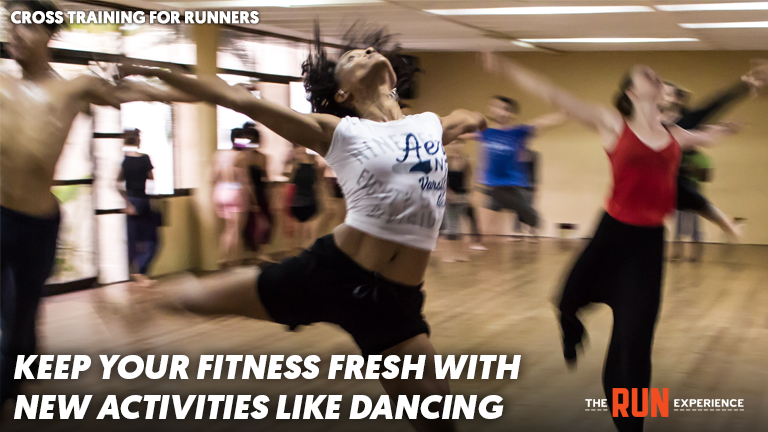Cross-Training for Runners: Benefits, Workouts & Exercises

There’s a reason cross-training for runners is mentioned in most online training programs and running books. Despite a runner’s love of racking up the miles, to be a strong and more injury-proof runner, it’s a good idea to mix up the training.
You don’t have to sign up for a triathlon to get the benefits, either. Keep your running workouts as your priority, but don’t be afraid to experiment with an alternative workout for the days you feel a little extra beat up or you just need to shake up the routine.
Cross-training is one of the best ways an athlete can build strength without overdoing it. There’s only so much running you can (and should) do at any given time, but switching up your workouts can help you chase down endorphins day after day without completely abusing the same muscle groups.
Below, we’ll explain more about what cross-training is and a few of our favorite cross-training exercises and workouts for runners. Here are a few of the questions we’ll answer below:
- What does cross-training mean?
- What are the best cross-training workouts for runners?
- Which cross-training exercises should I do?
- What are the benefits of cross-training?
What Is Cross-Training for Runners?
What’s cross-training? Great question.
Cross-Training Definition:
Cross-training is a mix of alternative workouts and exercises that’ll benefit your primary sport. As a runner, examples of cross-training include biking, yoga, strength training, climbing, and even soccer as forms of cross-training. And if you were a cyclist, you might consider walking and hiking (and maybe even running) as cross-training workouts for your primary sport.
Cross-training uses your body and muscles in different ways. When you’re running, you’re going through the same repetitive motions thousands of times, using your legs, core, and even your arms in the exact same patterns. Cross-training helps you switch it up.
For example, biking puts a different emphasis on your glutes, calves, quads, and hips. Not only do you build up minor muscles that might get neglected on your runs, but you train key muscles in new, challenging ways.
Diversify Your Schedule With a Runner’s Cross-Training Program
Not every cross-training regimen is going to work for runners. A runner’s cross-training program is going to prioritize different activities and scheduling.
For example, you might do your tempo run workout on a Monday, and use Tuesday as a cross-training recovery day with an easy swim or bike session. And you might use Wednesday as a light running day with a heavy weightlifting session in the evening.
Scheduling a runner’s cross-training can get tricky. But done right, it can help accelerate recovery, prevent injury, fix muscle imbalances, and improve your aerobic capacity.
Benefits Of Cross-Training
Before we dig into the best choices for cross-training and how to implement them, let’s make sure it’s clear exactly why you should take time to diversify your training schedule in the first place. Here are a few of the benefits of cross-training for runners.
Running is a high-impact, one-directional sport. We move forward, our arms swing back and forward, and that’s about it. Of course, you might jump over branches, step up a curb, or climb stairs. But the majority of the time, you’re moving in one plane of motion.
Using cross-training, you can target your body from multiple angles to develop more comprehensive body strength. For example, strength training allows you to use dynamic movements such as side lunges, bicycle crunches, or push ups. Just with those three exercises you get sideways (lateral) movement, rotation, and upper body strength work.
Cross-training also provides the opportunity for low-impact exercise while still getting your heart rate up. You can build your cardiovascular fitness, give your leg muscles a rest, and get a mental break all at the same time when you choose the right workout like swimming or using the elliptical machine.
With all that in mind, let’s go over some principles to follow when planning your cross-training. We’ll also have suggestions of which sports and exercises can give you the most bang for your buck when it comes to keeping you injury-free, helping you run faster, and staying strong.
The Best Cross-Training Exercises for Runners
The best cross-training exercises all depend on your goals and intention.
Want to strengthen your lower body for more explosive speed? The best cross-training exercises for this might be low-RPM, high-intensity biking sessions, or it might be weighted dumbbell calf raises.
Want to prevent injury and promote long-term health? The best cross-training exercises for this could be core and lower-body strengthening with easy pool sessions.
Here are a few universal cross-training exercises we recommend for all runners:
- Cycling: Cycling is a great way to add low-impact aerobic activities to your weekly volume.
- Swimming: Swimming helps build back, core, and shoulder strength with a no-impact cardio workout.
- Weightlifting: Weightlifting builds your primary and secondary running muscles, helping reduce injuries and build explosive speed.
6 Cross-Training Running Tips
1. Choose The Right Cross-Training Workout Routine For Your Purpose

It’s important to identify what you want to get out of your cross-training that day, whether that’s focusing on endurance, strength, recovery, or something else. If you’re meant to have a recovery day, it wouldn’t be a smart decision to do a spin workout on a bike.
On the other hand, if you’re using cross-training to target a speed workout, make sure you hit the same intensity that you would on the run. To cross-train smartly, you need to look for the same outcome you would have gotten with your run.
Best cross-training for recovery: Yoga, Pilates, Walking, Golf
2. Don’t Replace Running With Cross Training—Enhance It

Some days we have more aches and pains than others, and that’s normal! This is when cross-training workouts are so valuable, as it allows you to mimic the run workout you had planned without putting so much impact and stress on your joints and muscles.
Hop on a bike or a rower, or even jump in a pool, and complete the same workout you would do on the road without all the impact for a great cardio workout! Interval workouts, for example, transition easily from running to other methods of training.
But remember, these cross-training workouts alone won’t get you where you need to be by race day. Make sure running is still the focus, with these workouts being supplementary, and ideal for a day when your body or mind isn’t feeling 100%.
Best cross-training for cardio: Elliptical machine, Swimming, Biking, Aqua Jogging, Cross-Country Skiing, Dancing
3. Add Strength Training To Your Week

Adding whole-body strength training into your cross-training program once or twice per week will take your running to the next level. For example, training your glutes and your shoulders will target two of the powerhouse muscles used in running. Your glutes help you tackle the hills and prevent fatigue on the run. Your shoulders power a strong arm swing and keep your posture nice and tall over time.
Spending time on core strength is always a good idea, as well. A strong core also helps with your posture and reduces the occurrence of low back pain as it supports your body through the impact of running.
With just a couple of bodyweight-based strength workouts per week, you’ll still have plenty of gas in your tank to perform well on your runs while also ensuring that you stay strong enough to handle the miles. As a bonus, studies also show that strength training can help improve running economy. Just another way that some variety in your training can make you a better runner!
Best cross-training for strength: Weight training, Rock Climbing, Kayaking, Paddle Boarding
4. Add High-Intensity Work In Small Doses

In your run training, you want to alternate hard days and easy days to stay balanced. So if you hit the track for a tempo workout one day, avoid doing high-intensity interval training (HIIT) the following day. Doing both would essentially be like doing two track workouts back-to-back, which hinders our progress in the long run and can lead to running injuries.
This tip is especially important closer to race day when those run workouts are getting harder and harder. Around this time, focus more on your strength training and recovery, and give the HIIT workouts a rest until after race day.
Best cross-training for HIIT: rowing machine, spinning
5. Use Your Off-Season For New Cross-Training Activities

After a big race, your training possibilities are endless! This “off-season” period allows us to train as an all-around athlete, not necessarily just as a runner. This makes it the ideal time to focus on those HIIT workouts you avoided leading up to race day.
The best cross-training for runners in the off-season include activities that mimic running. Sports like cross-country skiing, snowshoeing, and even simple hiking doing a great job at this.
Bootcamp or circuit-style fitness classes are great options if you want a workout that’s already programmed for you. If not, just create your own workout using exercises that get your heart rate up. If you need ideas for workouts, don’t forget to check out our singles workouts in the app which are great cross-training for runners.
6. Keep Your Training Fresh With New Options

Mix it up! It’s so easy to fall into a routine during your off-season, always going to the same classes or doing the same workouts. One super-easy way to do this is to find some new locations for your workouts or runs. Use a trail-finding app to explore a new route if you usually hit the pavement for your run. If you’ve been using your living room as your gym, try your local park, instead.
Try to explore new workouts during this time to refresh your mind, as well. Running is a fantastic way to zone out and find what is almost moving meditation. Charge your mental game by finding a cross-training activity that makes you think about your next movement or have to recruit new ways of moving to stay sharp.
You’ll be more well-rounded and stronger as an athlete who has been exposed to a variety of workouts, movement patterns, and physical demands, all of which will help you be a better runner.
Top Cross-Training Workouts for Runners
Cross-training is an essential component of a runner's training regimen, helping to improve overall fitness, prevent injuries, and break the monotony of running every day. By incorporating different types of workouts, runners can enhance their strength, flexibility, and endurance, leading to better performance.
Here are some top cross-training workouts for runners. Remember, you don't need to do all of them. Pick one or two that you enjoy, or perhaps you can alternate week-to-week or month-to-month.
For example, you might incorporate cycling cross-training one week and swimming the next.
1. Cycling
Cycling is a low-impact activity that improves cardiovascular health, builds leg strength, and enhances endurance without putting excessive strain on the joints. It's particularly beneficial for improving quadriceps strength, which can be beneficial for runners.
Add 1-2 cycling sessions per week, focusing on steady rides or interval training to boost endurance and power. Indoor cycling classes are also a great option for structured workouts.
2. Swimming
Swimming is an excellent full-body workout that builds endurance and muscular strength with minimal impact on the joints. It also enhances lung capacity and breath control, which can benefit running performance.
Swim 1-2 times per week, alternating between longer, steady-paced swims and shorter, high-intensity intervals. Include different strokes to engage various muscle groups.
3. Strength Training
Strength training, including bodyweight exercises and weightlifting, increases muscle strength, improves running economy, and reduces the risk of injuries by correcting muscle imbalances.
Focus on compound movements such as squats, deadlifts, lunges, and upper-body exercises like push-ups and rows. Include 2-3 strength training sessions per week on non-consecutive days.
4. Yoga
Yoga improves flexibility, balance, and core strength. It also helps with mental focus and stress reduction. For runners, yoga can enhance range of motion and help prevent injuries by improving posture and alignment.
Practice yoga 1-2 times per week, focusing on poses that target the hips, hamstrings, and back. Restorative yoga can be particularly beneficial for recovery after long runs or races.
5. Pilates
Pilates strengthens the core muscles, which are crucial for running efficiency and stability. It also improves flexibility and posture, helping runners maintain form and reduce the risk of injuries.
Add a Pilates session 1-2 times per week, focusing on core strengthening exercises. Mat classes or equipment-based sessions can both be effective.
6. Elliptical Training
The elliptical machine provides a low-impact cardiovascular workout that mimics running motion without the hard impact, making it a good option for recovery days or runners with joint issues.
Use the elliptical for 30-60 minutes 1-2 times per week as a substitute for a running session, especially if you're recovering from an injury or looking for a low-impact alternative.
7. Rowing
Rowing is an effective full-body workout that builds cardiovascular fitness, endurance, and strength, particularly in the back, arms, and legs. It's also low-impact, reducing stress on the joints.
Include rowing sessions 1-2 times per week, alternating between steady-state rowing and intervals for variety and maximum benefit.
8. Hiking
Hiking on varied terrain builds leg strength, improves cardiovascular health, and enhances mental well-being. It's also beneficial for building endurance and can serve as active recovery.
Go for a hike once a week or bi-weekly, choosing trails that provide a mix of elevations and technical difficulty to challenge your body in different ways.
Start Adding Running Cross-Training Workouts to Your Program
Armed with choice, it’s up to you to find an optimal time to boost your training by leveling up your running performance and injury resistance. The best cross-training for runners is the training that actually happens—don’t invest in a running cross-training workout that won’t keep you committed.
Cross-training can be new and somewhat intimidating, but have fun with it. Learn something new. There are plenty of cross-training workouts out there—don’t get stuck doing one you hate.
Need help creating a running cross-training workout that works for you? Download our new mobile app. We incorporate cross-training into all our workout plans to give you the well-rounded training you need. We also provide access to coaching advice, daily video workouts, injury prevention tips, and our running community that will help motivate and inspire your training program!
